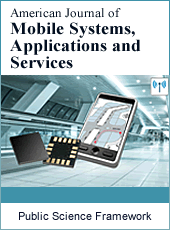American Journal of Mobile Systems, Applications and Services
Articles Information
American Journal of Mobile Systems, Applications and Services, Vol.4, No.4, Dec. 2018, Pub. Date: Dec. 23, 2018
Internet of Things Paradigms as Enablers of Ambient Assisted Living Systems
Pages: 27-32 Views: 2058 Downloads: 622
[01]
Amina El Murabet, Computer Engineering Department, National School of Applied Sciences of Tetouan, Abdelmalek Essaâdi University, Tetouan, Morocco.
[02]
Anouar Abtoy, Computer Engineering Department, National School of Applied Sciences of Tetouan, Abdelmalek Essaâdi University, Tetouan, Morocco.
[03]
Abderrahim Tahiri, Computer Engineering Department, National School of Applied Sciences of Tetouan, Abdelmalek Essaâdi University, Tetouan, Morocco.
The Internet of Things (IoT) has emerged in the last decade as Technological advancements that offers smart objects being capable of identifying, locating, sensing and connecting. The estimated population of connected IoT devices in 2018 is 23.14 billion and its forecasts to be 75 billion by 2025. In the other hand, another field has emerged; Ambient Assisted Living. These AAL applications and solutions are designed to face an urgent crisis facing the world: the increasing number of elder and senior citizens. AAL systems tend to offer a better life quality for these stakeholders, and at the same time, reducing the economic cost of this process for the society. The IoT and its paradigms become the enablers for many applications and domains such as Ambient Assisted Living systems. The objective of this study is to explore the two fields: Internet of Things and Ambient Assisted Living. In this paper, we present an overview of the Internet of Things. We also investigate the paradigms that make the Internet of Things area a successful and promising field. The seven layers and the technologies associated to IoT, the AAL generations are also discussed. Finally, we present the application domains and scenarios related to Internet of Things that serves the development of Ambient Assisted Living field.
Applied Computing, Internet of Things, Ambient Assisted Living
[01]
K. Ashton, “That ‘Internet of Things’ Thing,” RFID Journal, 2011.
[02]
D. Bandyopadhyay and J. Sen, “Internet of Things: Applications and Challenges in Technology and Standardization,” Wireless Pers Commun, vol. 58, no. 1, pp. 49–69, May 2011.
[03]
D. Miorandi, S. Sicari, F. De Pellegrini, and I. Chlamtac, “Internet of things: Vision, applications and research challenges,” Ad Hoc Networks, vol. 10, no. 7, pp. 1497–1516, Sep. 2012.
[04]
L. D. Xu, W. He, and S. Li, “Internet of Things in Industries: A Survey,” IEEE Transactions on Industrial Informatics, vol. 10, no. 4, pp. 2233–2243, Nov. 2014.
[05]
R. Khan, S. U. Khan, R. Zaheer, and S. Khan, “Future Internet: The Internet of Things Architecture, Possible Applications and Key Challenges,” in 2012 10th International Conference on Frontiers of Information Technology, 2012, pp. 257–260.
[06]
A. Al-Fuqaha, M. Guizani, M. Mohammadi, M. Aledhari, and M. Ayyash, “Internet of Things: A Survey on Enabling Technologies, Protocols, and Applications,” IEEE Communications Surveys Tutorials, vol. 17, no. 4, pp. 2347–2376, Fourthquarter 2015.
[07]
F. Hussain, “Internet of Everything,” in Internet of Things, Springer, Cham, 2017, pp. 1–11.
[08]
M. H. Miraz, M. Ali, P. S. Excell, and R. Picking, “A review on Internet of Things (IoT), Internet of Everything (IoE) and Internet of Nano Things (IoNT),” in 2015 Internet Technologies and Applications (ITA), 2015, pp. 219–224.
[09]
B. D. Martino, K.-C. Li, L. T. Yang, and A. Esposito, “Trends and Strategic Researches in Internet of Everything,” in Internet of Everything, Springer, Singapore, 2018, pp. 1–12.
[10]
F. Wortmann and K. Flüchter, “Internet of things,” Business & Information Systems Engineering, vol. 57, no. 3, pp. 221–224, 2015.
[11]
S. Vashi, J. Ram, J. Modi, S. Verma, and C. Prakash, “Internet of Things (IoT): A vision, architectural elements, and security issues,” in 2017 International Conference on I-SMAC (IoT in Social, Mobile, Analytics and Cloud) (I-SMAC), 2017, pp. 492–496.
[12]
G. Sebestyen, A. Hangan, S. Oniga, and Z. Gál, “eHealth solutions in the context of Internet of Things,” presented at the Automation, Quality and Testing, Robotics, 2014 IEEE International Conference on, 2014, pp. 1–6.
[13]
M. Vega-BarbasDiego Casado, D. Casado Mansilla, and M. Ángel Valero Duboy, “Smart Spaces and Smart Objects Interoperability Architecture (S3OiA) - Semantic Scholar,” presented at the Innovative Mobile and Internet Services in Ubiquitous Computing (IMIS), 2012 Sixth International Conference on, 2012.
[14]
A. Dohr, R. Modre-Opsrian, M. Drobics, D. Hayn, and G. Schreier, “The Internet of Things for Ambient Assisted Living,” in 2010 Seventh International Conference on Information Technology: New Generations, 2010, pp. 804–809.
[15]
J. Wan, X. Gu, L. Chen, and J. Wang, “Internet of Things for Ambient Assisted Living: Challenges and Future Opportunities,” in 2017 International Conference on Cyber-Enabled Distributed Computing and Knowledge Discovery (CyberC), 2017, pp. 354–357.
[16]
L. Atzori, A. Iera, and G. Morabito, “The internet of things: A survey,” Computer networks, vol. 54, no. 15, pp. 2787–2805, 2010.
[17]
J. Cubo, A. Nieto, and E. Pimentel, “A cloud-based Internet of Things platform for ambient assisted living,” Sensors, vol. 14, no. 8, pp. 14070–14105, 2014.

ISSN Print: 2471-7282
ISSN Online: 2471-7290
Current Issue:
Vol. 5, Issue 1, March Submit a Manuscript Join Editorial Board Join Reviewer Team
ISSN Online: 2471-7290
Current Issue:
Vol. 5, Issue 1, March Submit a Manuscript Join Editorial Board Join Reviewer Team
| About This Journal |
| All Issues |
| Open Access |
| Indexing |
| Payment Information |
| Author Guidelines |
| Review Process |
| Publication Ethics |
| Editorial Board |
| Peer Reviewers |


